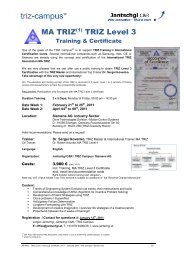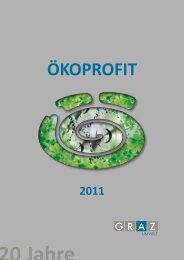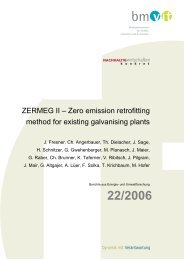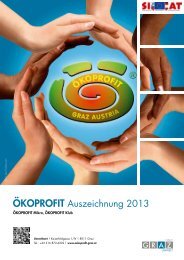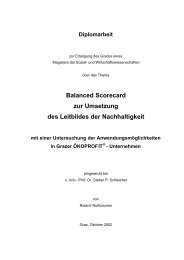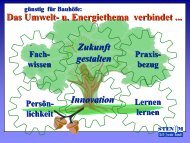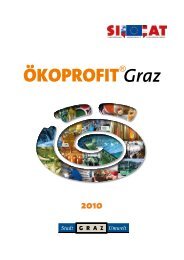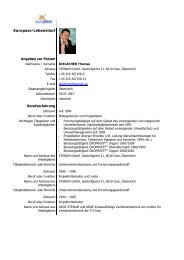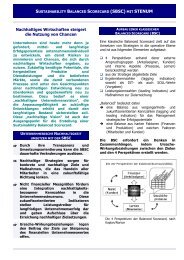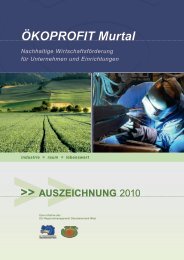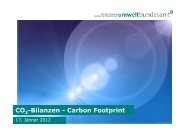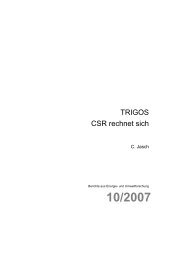Promoting Resource Efficiency in Small & Medium size ... - UNEP
Promoting Resource Efficiency in Small & Medium size ... - UNEP
Promoting Resource Efficiency in Small & Medium size ... - UNEP
You also want an ePaper? Increase the reach of your titles
YUMPU automatically turns print PDFs into web optimized ePapers that Google loves.
Purchased 10 kg<br />
E<strong>in</strong>kaufsmenge 10.0kg<br />
Varnish 8 kg, th<strong>in</strong>ner 2 kg<br />
Varnish -6 kg<br />
Purchased -7,84 kg<br />
Th<strong>in</strong>ner – 1,8 kg<br />
Prepared varnish<br />
8,5 kg<br />
Residual varnish 1 kg<br />
Prepared varnish - 6,6 kg<br />
Th<strong>in</strong>ner<br />
– 1,3 kg<br />
Applied varnish<br />
7,5 kg<br />
2.5kg<br />
Overspray<br />
5.0kg<br />
Th<strong>in</strong>ner 1,5 kg<br />
Applied varnish - 5,7 kg<br />
- 1,25 kg<br />
Overspray<br />
- 4,4 kg<br />
Residual varnish<br />
–0,9 kg<br />
Solvent <strong>in</strong> exhaust air<br />
3,5 kg<br />
Solvent <strong>in</strong> exhaust air<br />
– 3,4 kg<br />
Solvent <strong>in</strong> exhaust<br />
air 1,5 kg<br />
Solids <strong>in</strong> exhaust air<br />
0,1 kg<br />
Solvent <strong>in</strong> exhaust air<br />
– 1,3 kg<br />
Solids <strong>in</strong> exhaust air – 0,1 kg<br />
Dust 0,1 kg<br />
Dust – 0,1 kg<br />
Sludge 1,3 kg<br />
Sludge – 0,9 kg<br />
Dry varnish film<br />
on workpiece 1 kg<br />
Dry varnish film on<br />
workpiece 1 kg<br />
Figure 17: Material flow analysis for pa<strong>in</strong>t<strong>in</strong>g a car <strong>in</strong> an auto repair shop<br />
(the green arrow is the product (dry pa<strong>in</strong>t on the part), the red arrows <strong>in</strong>dicate<br />
wastes and emissions)<br />
Figure 18: Optimal material flow analysis for pa<strong>in</strong>t<strong>in</strong>g a car <strong>in</strong> an auto repair<br />
shop (the green arrow is the processed product, the red arrows <strong>in</strong>dicate wastes<br />
and emissions)<br />
processed product (usually car body parts that have to be coated), the<br />
red arrows <strong>in</strong>dicate wastes and emissions such as the th<strong>in</strong>ner which is<br />
used for clean<strong>in</strong>g the tools, extra pa<strong>in</strong>t which is prepared but not used,<br />
solvent <strong>in</strong> the exhaust air result<strong>in</strong>g from the evaporation of the solvent<br />
of the pa<strong>in</strong>t and sludge generated from overspray.<br />
Figure 18 shows a best practice situation us<strong>in</strong>g the latest technology –<br />
e.g. automatic equipment to clean the guns, high volume, low pressure<br />
guns.<br />
The generation of Cleaner Production Options is at the heart of the<br />
activities of a <strong>Resource</strong> <strong>Efficiency</strong> project. There are different strategies<br />
to identify options:<br />
- Use of manuals and checklists<br />
- Ask equipment suppliers<br />
- Use the creativity of the <strong>Resource</strong> <strong>Efficiency</strong> team<br />
<strong>Resource</strong> <strong>Efficiency</strong> options can also be derived from <strong>in</strong>formation from<br />
suppliers who will be glad to give you <strong>in</strong>formation on the specific<br />
performance data for material and energy consumption of their<br />
equipment.<br />
While identif<strong>in</strong>g options for your company it is common to encounter<br />
some difficulties raised by personnel; typical concerns <strong>in</strong>clude:<br />
• We have always worked like this.<br />
• We are too big/too small for this.<br />
• Do not forget we have to earn money.<br />
• This does not affect my department.<br />
• Nobody told me what to do.<br />
• It is not my bus<strong>in</strong>ess.<br />
• I am very busy.<br />
• Let someone else do this.<br />
• I did not understand.<br />
• It is too early for this or it is too late now.<br />
To overcome these barriers there are a number of methods to help break<br />
up these limits to our perception.<br />
It is valuable to divide the process of creative problem solv<strong>in</strong>g <strong>in</strong>to four<br />
stages as shown <strong>in</strong> Figure 19: i) Problem analysis, ii) Idea f<strong>in</strong>d<strong>in</strong>g, iii)<br />
Evaluation and iv) Realisation.<br />
i) Problem analysis: The po<strong>in</strong>t of this phase is to arrive at a clear<br />
description of the problem. It is here that the focus should be drawn to<br />
the actual problem; for example, what is the source of our waste and<br />
emissions? Document the boundary conditions of the problem and<br />
document the history of the problem; for example, what has been done<br />
<strong>in</strong> the past to solve the problem, what has worked, what has not worked?<br />
ii) Idea f<strong>in</strong>d<strong>in</strong>g: The po<strong>in</strong>t of this phase is to take a step back from<br />
the problem and look at it from a bird’s-eye view. Idea f<strong>in</strong>d<strong>in</strong>g is done<br />
on an abstract level and should build on all available <strong>in</strong>formation. In this<br />
phase there is absolutely no criticism. The goal is to end up with as many<br />
creative ideas as possible. Idea f<strong>in</strong>d<strong>in</strong>g is also known as bra<strong>in</strong>storm<strong>in</strong>g.<br />
iii) Evaluation: In the evaluation phase, ideas from the previous phase<br />
are evaluated one-by-one on the merits of their technical feasibility,<br />
their economic payback time and their ecological impact. After a strict<br />
evaluation, the most promis<strong>in</strong>g options are selected.<br />
iv) Realisation: In this phase, ideas selected from the process are<br />
implemented. For each activity, a team member will be assigned to follow<br />
up the process of implementation. Implementation can be straightforward,<br />
if the identified activity is, for example: to change set po<strong>in</strong>ts or recipes,<br />
it can <strong>in</strong>volve the def<strong>in</strong>ition of work<strong>in</strong>g procedures and tra<strong>in</strong><strong>in</strong>g; it can<br />
<strong>in</strong>volve the design of revamps or the selection of suppliers, a bidd<strong>in</strong>g<br />
procedure or the supervision of the supply.<br />
There are a number of factors that <strong>in</strong>fluence the efficiency of the creative<br />
process. Individual factors <strong>in</strong>volve the personalities of the people<br />
<strong>in</strong>volved <strong>in</strong> the process, their age, their experience, <strong>in</strong>tellectual versatility,<br />
and also their motivation and disposition. Organisation factors <strong>in</strong>clude<br />
24



